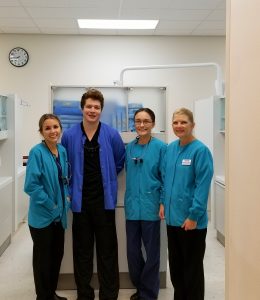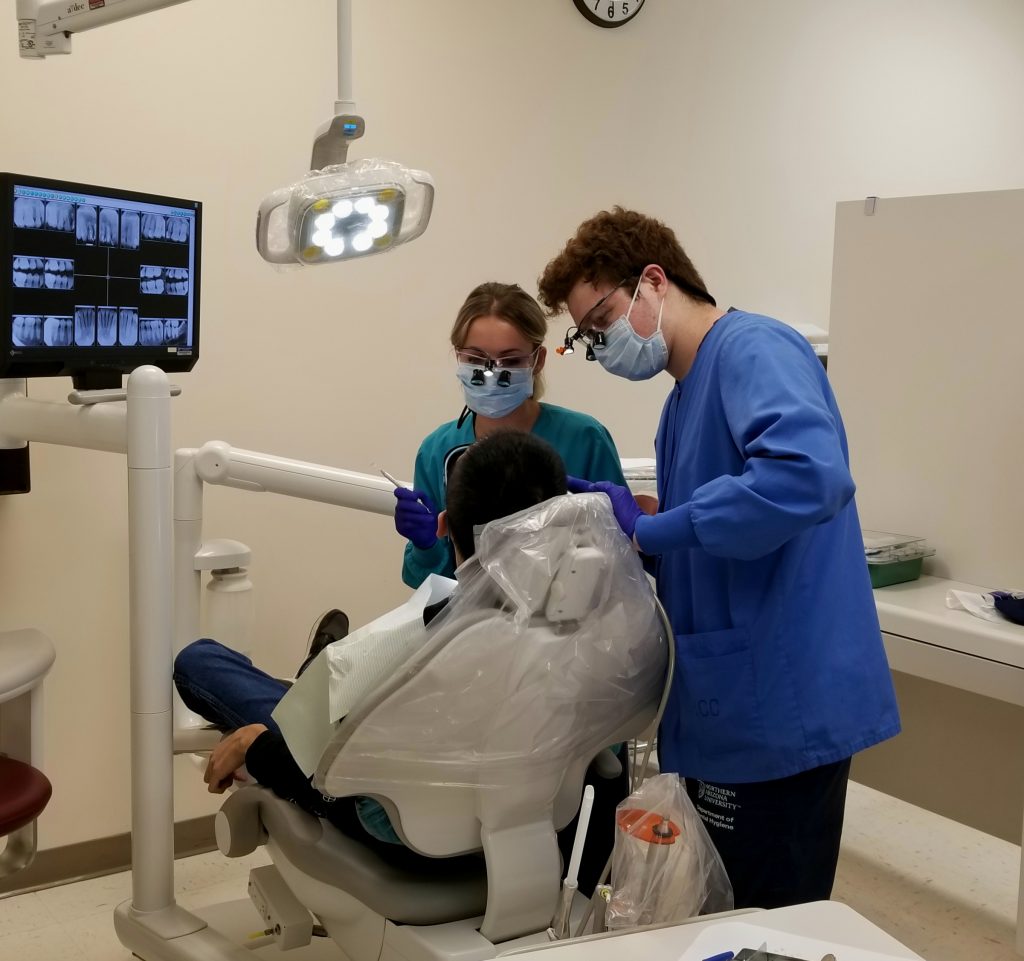March 13, 2019
Heather Steagall was apprehensive when a 47-year-old man who’d never gotten his teeth cleaned walked into the clinic where three Northern Arizona University dental hygiene students were helping patients. She pulled aside the two who would help him and cautioned them to be gentle and to walk him through every step of what they were doing. She didn’t want him to have a negative experience and possibly go another 47 years without care.
The students, all seniors in the dental hygiene program who were doing a rotation at the Hopi Health Care Center (HHCC) in Polacca, two hours northeast of Flagstaff, took their time, walking the patient through the cleaning. That is not an atypical experience, said Steagall, who has been the coordinator of NAU’s Hopi Program for two years; often, their patients have medical conditions that complicate a dental appointment or haven’t seen a dentist in many years and have significant buildup, periodontal concerns and sensitivity.
“You really want to make their first experience with a cleaning a good one,” said Steagall, an assistant clinical professor in the department. “I try to pass that along to students, that it’s important to make it a positive experience. We have a lot of patients with extreme sensitivity that can be hard to work with—if you just barely touch gums or a tooth and it causes pain, it can be a real challenge to work on the patient.”
The program, which is funded by the John and Sophie Ottens Foundation, helps meet two needs: providing much-needed oral health care to the Hopi population and a diverse experience for the dental hygiene students.
“Their services are in such high demand I would love to have them here all year long,” said Dr. Gary Wilson, chief of the dental service at HHCC. “The direct benefit to the patient is improved oral health and medical health. In some patients, the need is so great that they have been placed on two- to three-month intervals between hygiene appointments in an effort to reduce the handicapping effects of periodontal disease.”
A day at the Hopi Health Care Center
The students participate in a three-day rotation, working 10 a.m. to 5 p.m. Wednesday and 8 a.m. to 5 p.m. Thursday and Friday at the dental clinic. The students pair up, with two seeing one patient for a two-hour block. It’s a little longer than the average dental cleaning, Steagall said; the students check vital signs and get medical history, then do a periodontal assessment—checking gums and teeth and determining what kind of cleaning the patient needs before beginning treatment.

Then they start cleaning, with Steagall stopping by to check in at each step of the process to evaluate the students’ work.
“A lot of patients at Hopi haven’t been to a dentist in many, many years,” she said. “There are lots of really difficult cases that students treat.”
After the last patient of the day, the group retires to an NAU-owned trailer, where they stay for two nights. They do a post-huddle, talking through their experiences, asking questions and sharing ideas. Steagall is in charge of planning dinner, and usually the students all pitch in to help cook and clean, and they sit around the table together eating and continuing their discussions.
“They always have something to share that they learned about in class but hadn’t seen in clinic, so being able to apply that to the real world, they find that really useful,” she said. “They always comment on how much they learn. We try to fashion the experience at the HHCC after real world experiences as it’s not so structured as it can be at the NAU Dental Hygiene Clinic and experiences can vary greatly from patient to patient.”
After dinner, students typically do homework, relax or some combination of the two, Steagall said. The trailer includes a small computer lab that allows them to access patient records and schedules, and there’s also a TV and Internet access. On Thursday and Friday mornings they return to the clinic, and Friday evening, after a final post-huddle, the students return to Flagstaff.
This is one of four off-campus rotations dental hygiene students participate in during their senior year; they also go to the Yavapai/Apache clinic in Camp Verde, the Flagstaff Medical Center and North Country Health Care. The department also has a clinic on campus where students treat local patients. One of the graduation requirements for students is to work with a variety of patients, and the rotations help to introduce diversity into their experiences. This rotation in particular puts students into contact with people of all ages, genders, backgrounds and health conditions.
Some of that diversity includes the way patients approach health and medicine. The Hopi people often use holistic approaches to health, so it’s not unusual to hear that patients went to a medicine man for treatment or used natural techniques instead of medications.
“You have to be open to that,” Steagall said. “You can’t just shut them out because they may not come back. Again, you really want to make it a positive experience for them.”
She also reminds students of another cultural difference. They are visitors there, she tells them over and over again, and they need to be respectful of the Hopi tradition of quiet. On several occasions, she has had to ask students to lower their voices and be cognizant of the peaceful nature of their culture.
The importance of dental care
The dental clinic and the NAU students provide a much-needed service to people in these rural areas, for whom the clinic is the closest option for dental care. Wilson, chief of the dental service at HHCC, said the importance of good hygiene cannot be overstated.
Dental care, in addition to improving smiles and reducing sensitivity while eating and drinking, is directly correlated with people’s health. At the Hopi Health Care Center, this is even more significant, as there is a larger percentage of the population with diabetes, heart disease and other medical conditions.
“For many years now, a preponderance of the literature has shown a direct relationship between good medical health—conditions including heart disease, diabetes, alcohol and other chemical abuse and poor nutritional intake—with good oral health,” Wilson said. “This important relationship is associated specifically with the periodontal health of the patient. The dental hygienist plays a crucial role in helping patients struggling to improve the health of the periodontal complex.”
And the patients are benefitting. They can fill out an anonymous survey, and the reviews are always glowing. Steagall said she’s had patients invite her and the students to ceremonies, such as the Bean Dance, which is a series of rituals that promote fertility and germination, or express their appreciation through food. She laughed as she recalled one man’s outreach.
“He went out and bought burritos for everybody and brought them back and wanted to share them with us,” she said. “Patients also are eager to talk about their culture to the students, teaching them Hopi words like askwali, which means thank you as said by females. The patients are always very appreciative of the care they receive.”
And the 47-year-old experiencing the dentist for the first time? He’s since come back with a continued interest in his oral health.
History of the Hopi rotation
This rotation began in 2003, making it the longest-running volunteer health care program serving the Hopi people. Dental hygiene professor Denise Helm was instrumental in getting the program started. The John and Sophie Ottens Foundation, a nonprofit that provides scholarship and grant opportunities for Native American students and programs, paid for the purchase of the trailer and its associated costs as well as for the program coordinator.
Helm said she saw a need for such a partnership since most of the patients that students see at NAU’s clinic are students or retired people who don’t have a lot of complex oral health needs. Many patients at the HHCC do have greater needs, and the center needed dental hygienists.
“It was a win-win,” she said. “The Hopi Health Care Center needed help with hygiene care, and our students get experience with more involved patients. Even more important than the clinical skills that students gain, they gain an appreciation and better understanding for working with rural populations and diverse populations.”
In addition to working at the clinic, Helm said students have gone into schools and do sealants and screenings. It’s a true public health experience, she said, which is valuable for students who are considering a career in public health. She’s grateful both to the Ottens Foundation and the HHCC for partnering with NAU in this program, she said.
The rotation only goes during the spring and fall semesters, but Steagall started an externship program for the summer and takes three students out for two weeks and they spend every day working with patients at HHCC.

(928) 523-8737 | heidi.toth@nau.edu



